In-Depth with the Windows 8 Consumer Preview
by Andrew Cunningham, Ryan Smith, Kristian Vättö & Jarred Walton on March 9, 2012 10:30 AM EST- Posted in
- Microsoft
- Operating Systems
- Windows
- Windows 8
There are two versions of Internet Explorer 10 in Windows 8—a Metro app and a desktop app. Both share the same rendering engine and, unsurprisingly, perform identically on the same hardware. The only difference is UI, and the fact that Metro’s IE will not run plug-ins like Adobe Flash or Microsoft’s own Silverlight.
To reflect the distinction between the Metro version of IE and the desktop version, both Metro and the desktop retain separate default browser settings—you can run Firefox or Chrome as your default browser on the desktop and stick with IE in Metro, but you can also specify desktop browsers as the default Metro browser, meaning that links clicked in Metro apps like Mail will dump you to the desktop to open rather than stay in the Metro interface. Oddly, if you decide not to use IE as your default Metro browser, the IE completely disappears from Metro, and it takes a trip into the desktop Internet Settings control panel to re-enable it.
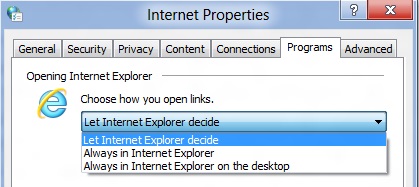
The Metro version of IE is a minimalist, touch-centric affair—the address bar is located at the bottom of the screen, and will disappear from view when it’s not being used. While typing in the address bar, IE will display a tiled list of your most frequently visited sites, as well as sites that you have “pinned” using the address bar’s pin button—these pinned sites will also show up on the Start screen. The address bar also has the requisite Back, Forward, and Refresh buttons, as well as a Tools button that will let you search the current page or open the page in the desktop version of IE (the desktop version contains no such button to open pages in Metro mode, at least for now).
The most consistent way to bring up the address bar on a PC is by using the Windows + Z keyboard shortcut that we discussed earlier, which will also bring up Metro IE’s tab interface, which displays big, clickable thumbnails of all your open tabs. You can also open new tabs, clean up your tabs (which closes all but the active tab), or open a new InPrivate browsing tab, which is clearly marked with a blue “InPrivate” icon.
The desktop version of IE looks more or less like IE9, though of course the UI hasn’t necessarily been finalized at this point. One of the only noticeable differences is the presence of a Metro-style scrollbar on pages that require one. Also new is an “Install new versions automatically” checkbox in the About Internet Explorer page, reinforcing Microsoft’s desire to get and keep Windows users on the most current IE version their operating system supports. There’s no evidence that Microsoft plans to move to the rapid-release cycle that Google and Mozilla have both adopted (such a decision would give enterprise IT managers apoplexy), but this sort of functionality would theoretically make it possible.
Benchmarks
Now, let’s peek under the hood and get a few performance numbers. According to these basic tests, IE10 is faster than IE9 by a noticeable margin, but it can’t quite catch up to the current versions of Firefox or Chrome. These benchmarks were all run on the Dell Latitude E6410 that served as my main Windows 8 machine for this review.
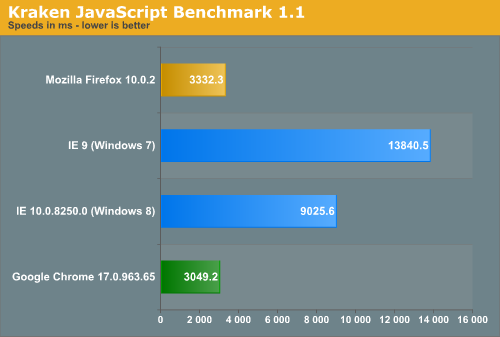
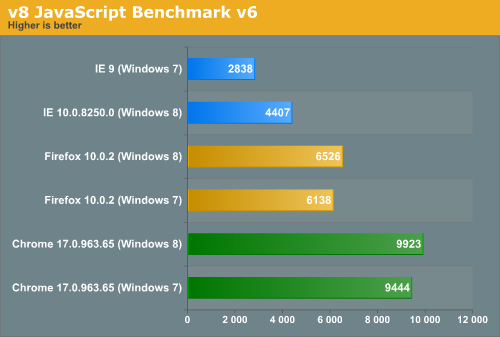
Interestingly, all browsers performed the v8 benchmark slightly faster in Windows 8. The difference isn’t huge—just a few hundred points in both cases—but it is both consistent and measureable, and I thought it interesting that the OS update slightly improved the performance of these third-party programs. Kraken scores were consistent across Windows 7 and Windows 8.


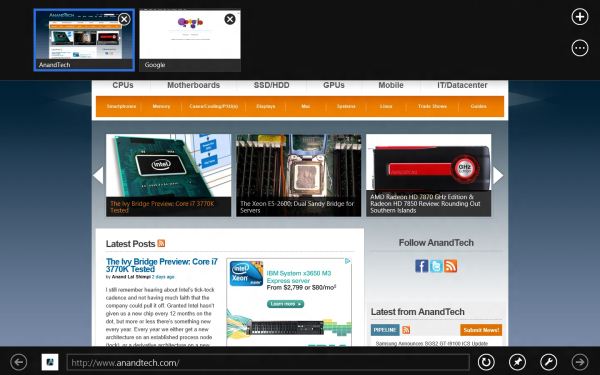
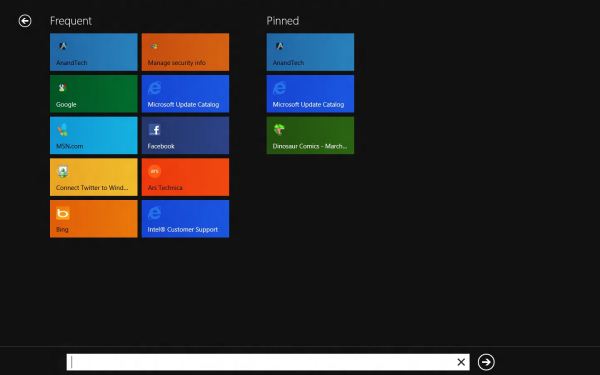
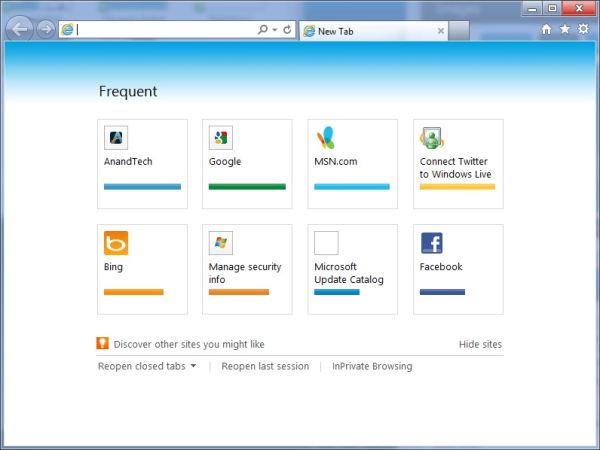








286 Comments
View All Comments
Andrew.a.cunningham - Friday, March 9, 2012 - link
Good call. Will tweak.cserwin - Friday, March 9, 2012 - link
With Apples iOS, I am constantly amazed at how good the applications are. The best of them have such a higher focus on doing a job well. There is little bloat, not much feature creep... it's been really revealing with the iPad at how pleasurable it is to use good, elegant applications that do their jobs well.So, while Windows 8 as an OS may merge the desktop and tablet space, the elephant in the room seems to be the level of bloat in windows applications. Yes, a Windows 8 table would be able to run Windows applicaitons, but as a tablet user, I cannot think of a single Windows application that I would actually like to run on a tablet.
Until application develpers start developing applications that can deliver satisfactory experiences in both workstation and tablet usage models, the common OS doesn't do much.
While windows 8 gets to a unified OS ahead of OSX and iOS, with apple there is the full iLife and iWork suite, not ot mention 3rd part apps (photoshop, sketchbookpro, etc.).
It's going to be interesting to see these things play out. Microsoft seems to be banking on 'if you build it they will come'. But apple has the tablet user base, and that's where the developers are going to go.
cserwin - Friday, March 9, 2012 - link
I'll follow up with a question -What is Microsoft doing to help developers improve their applications to provide value in both tablet and workstation usage models?
I'd be interested in an article that addressed this.
Andrew.a.cunningham - Friday, March 9, 2012 - link
Sure! I'm paying attention to the comments to shape the sort of things we look at in the RTM article, and we'll be able to say a bit more about Metro apps when we've actually got some ready-for-primetime products to evaluate.Off-hand, I'd suggest that one theoretical value-add is the ability to run the same app with the same features on both tablets and PCs - this can create more consistency and predictability for users, and frees developers from having to maintain an app for Metro and an app for the desktop.
futurepastnow - Friday, March 9, 2012 - link
Here's something for your RTM article. Sit someone's non-techie mother* down in front of a Win8 desktop PC with no prompting or instructions except to use it like normal.Someone with no prior Metro experience, no Microsoft Account, no touchscreen. Someone who doesn't have any keyboard commands memorized. Someone just like the millions of normal folks who will be buying Win8 PCs cold and taking them home soon.
*no insult towards mothers intended
jabber - Friday, March 9, 2012 - link
This is exactly what I have been doing with folks and its been carnage.Apple must think its going to clean up when folks go to buy their next PC in 12 months time.
The stink of Vista still hangs around with folks and MS cant afford another FU like that.
Thats why W7 was so good as it looked like MS was listening to customers at last.
Metro looks like it was designed by hipsters for hipsters.
PopinFRESH007 - Sunday, April 15, 2012 - link
Metro looks like it was designed by "people who think they are" hipsters for "people who think they are" hipsters.there, fixed that for ya.
Andrew.a.cunningham - Friday, March 9, 2012 - link
Apple has the tablet userbase, but Microsoft has the desktop/laptop userbase, and one of it's goals with Win8/Metro/WinRT is to attracted devs with its desktop marketshare and then grow tablet marketshare from there.I completely agree that the Windows Store is one of the biggest wildcards in Windows 8 right now, and it's one we know the least about - we won't know if it's going to attract developers and succeed until it attracts developers and succeeds. :-)
medi01 - Monday, March 12, 2012 - link
iOS on Tablets will soon get what it deserves: about 15-20% of the market, so you better compare Windows to Android.PS
"Higher focus", eh?
And iTunes is a great program, I guess...
GotThumbs - Friday, March 9, 2012 - link
Who was the first to have a tablet out in the market? It was NOT Apple. I have a Motion Computing LS800 tablet in my office that's older than any tablet from Apple. Yes, Apples IPAD is the reason for sparking the tablet market to what it is today, but tablet PC's have been used in health care and education industries for more than 10 years before now. I'm not disputing Apples IPad has created tremendous growth/opportunity for other tablet makers, but lets not overlook the truth to feed Apples ego.Truth/accuracy in all media please.
"In 1989, the GRiD GRiDPad was released. In 1991, there was the GO PenPoint. In 1992, Microsoft released Microsoft Windows for Pen Computing, which had an API that developers could use to create pen-enabled applications. In 1993, a smaller device that you are more likely to have seen or read about was released—the Apple Newton"
Source:http://www.developer.com/ws/other/article.php/1500...